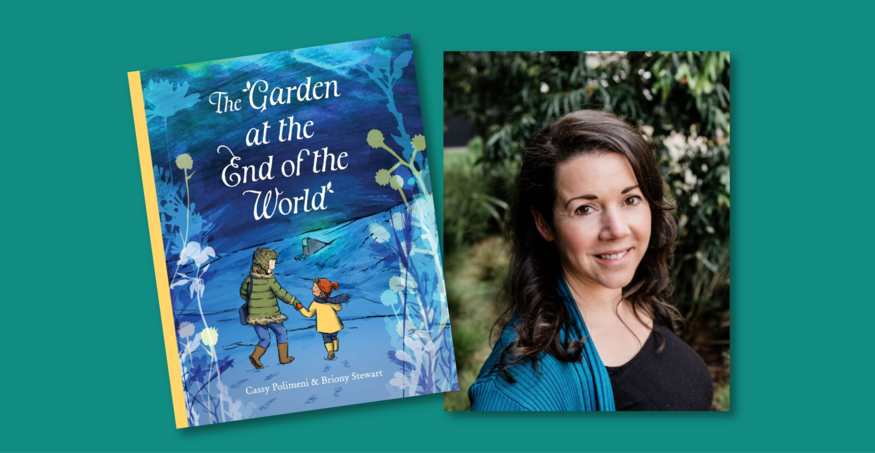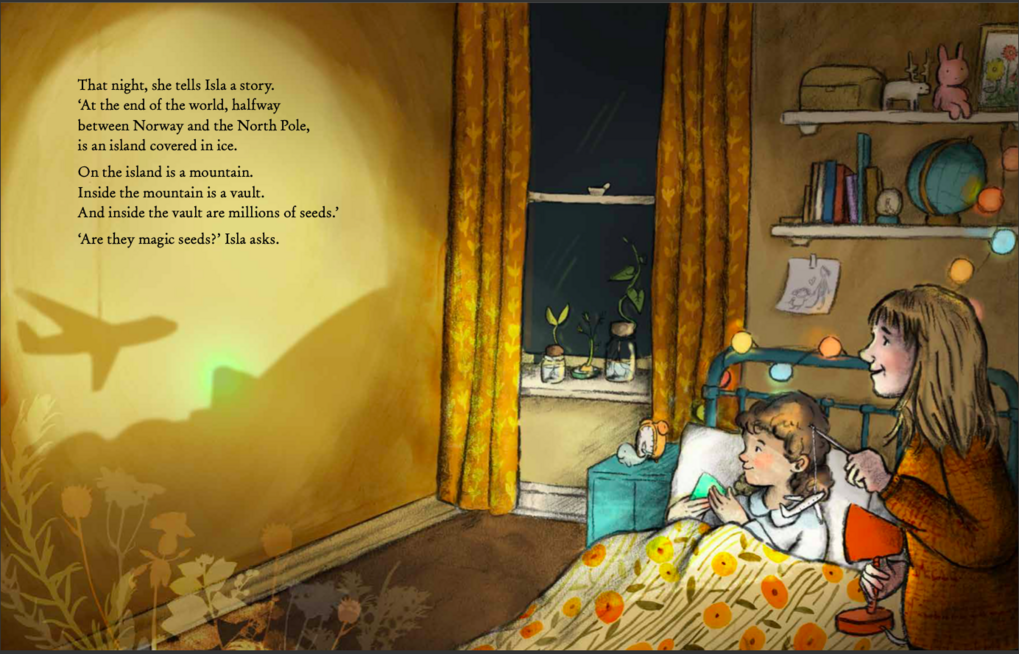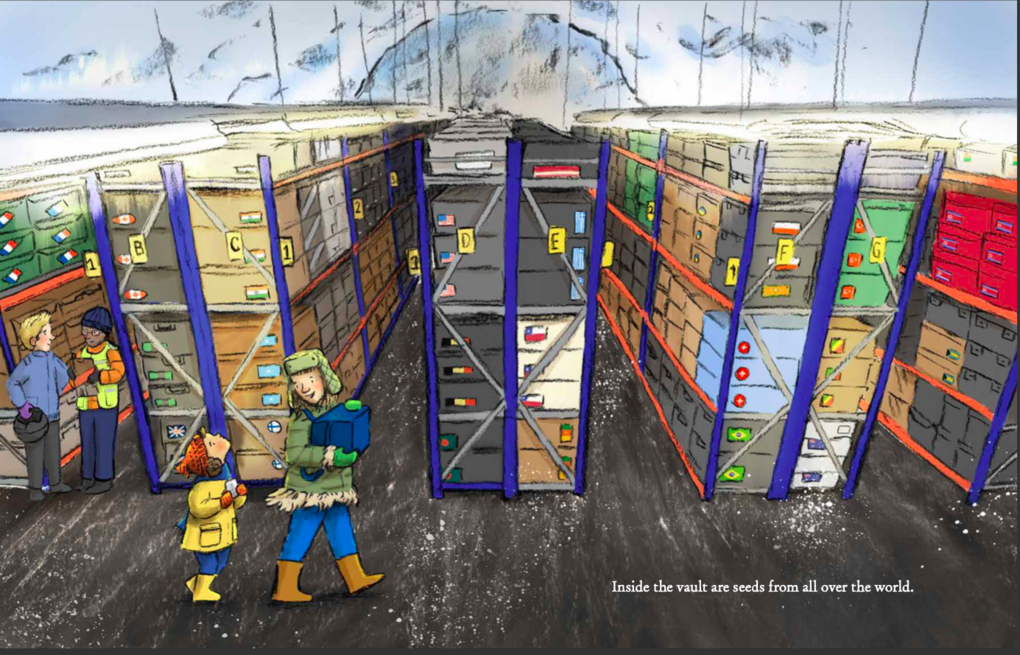The Generational Impact of Svalbard

23 August 2024
Many of us can recall our most cherished childhood novels and picture books. They are the stories that lulled us to sleep each night with tales of faraway lands and magical creatures dancing across our minds. Beyond their colorful illustrations, these stories often held important themes buried between the lines – lessons of right and wrong, good and evil, love and bravery. These books had the power to instill key values within the young minds of their readers. Values they carry throughout the rest of their lives.
But what if there was a children’s story that spoke to the significance of crop diversity? For Cassy Polimeni, author of The Garden at the End of the World, her long-time fascination with the Svalbard Global Seed Vault motivated her to write a children’s picture book exploring food security and conservation. The Garden at the End of the World is about a young girl who discovers a rare plant near her home while foraging with her botanist mother. At first, she wants to keep the strange and beautiful seed pod, but when her mother tells her about the Global Seed Vault and its importance, she realizes the seeds belong there. Together, they journey to deliver the pod to the Seed Vault.
Illustrated by award-winning creator Briony Stewart, this book is a powerful reminder that the key to navigating climate change relies on hope and wonder rather than despair. I sat down with Polimeni to discuss the book's inspiration and how she translates heavy topics for a younger audience. Read below for the full interview.

Crop Trust: What motivated your interest in the Svalbard Global Seed Vault? Were you always passionate about conservation and crop genetic diversity, or did learning about the work done at the Vault spark your interest in this field?
Cassy Polimeni: I’ve been interested in conservation since I was a child. I had keen gardeners for grandparents on both sides, so I grew up surrounded by heirloom seeds and homegrown fruit and vegetables, although I probably took it all a bit for granted when I was younger. But learning about the Global Seed Vault was definitely the inspiration for my book The Garden at the End of the World. When I first heard about the Vault it felt like something out of a fairytale – precious resources hidden in a frozen mountain for the good of humanity, the remote location and spectacular Arctic landscape, the sparkly green art installation lighting the entrance. Sometimes true stories are stranger and more magical than fiction, and the science and intent behind the Global Seed Vault feels like a perfect example of this.
Was it challenging to articulate the purpose of the Seed Vault in a way that children are able to absorb?
Cassy Polimeni: The biggest challenge is figuring out how to express huge, abstract concepts in a way children can relate to. Briony’s gorgeous illustrations are a big part of making this story accessible and relatable to young readers. She was inspired to use plants in different ways in the illustrations, including charcoal (burnt wood) for the line work and cyanotypes (sun prints) of plants for the endpapers and the silhouetted plants of Isla’s imagination that you see throughout the book.
When I present workshops in schools I sometimes begin by holding up a tiny bag of seed samples and talk about how what's inside could feed hundreds of people, or their great grandchildren, as a way of visually showing the potential of seeds. In the book, Isla’s mother tells her the Vault exists so that “children who haven’t even been born yet will be able to grow and eat the foods we love”. Simple phrases and visuals can help distill big concepts.
Another challenge when writing for kids is ensuring that all stories, even true stories, contain an element of hope. The existence of the Global Seed Vault is inherently hopeful but the reasons it exists – to protect food security and crop diversity from threats such as climate change or war – is heavy and has to be handled in a way that is honest while still feeling hopeful.

Given that a key tenet of the Seed Vault’s existence is to preserve access to seeds for future generations (i.e the readers of this book), do you think there should be greater efforts to educate children about the Global Seed Vault and the work being done across the globe to promote biodiversity and food security?
Cassy Polimeni: It’s certainly worth thinking about. When I present workshops for children, there is always a huge appetite for information about the Vault. For many kids (and their parents!), reading the book is the first time they've heard about it. And they're fascinated to learn how it works, to guess what the plants the seed samples I bring along will grow into, and to learn that cyanotype prints (like the ones on the books' endpapers) were used in early scientific research to document plants before photography as we know it today existed.
Again, I think the key is balance. Particularly with young kids, it's important to tread carefully with this information and prioritize wonder rather than responsibility. That the Vault exists is incredible, that there are so many wonderful scientists and conservationists working to preserve our most important resources is heartening. Conveying a hopeful message will help protect kids' mental health and avoid burnout, so they are strong enough to pick up the baton when it's their turn to join the fight.
At the Crop Trust, we certainly hope this book fills kids minds with wonder and stays with them for a long time. We want to thank Cassy Polimeni for taking the time to talk with us and look forward to hearing more about her work with kids on the Seed Vault.

About the Author
Cassy Polimeni is an Australian children's author with an interest in environmental issues, and the relationship between science and wonder. Her debut picture book The Garden at the End of the World (University of Queensland Press) was longlisted for Picture Book of the Year by the Children's Book Council of Australia, and her new junior fiction title Ella and the Amazing Frog Orchestra (the first in a series with University of Western Australia Publishing) explores the importance of frogs as an indicator species. The former editor of Destinations Australia magazine, Cassy now works as a freelance editor and children's author and presents workshops for children focussing on conservation, habitat protection and the Svalbard Global Seed Vault in her books at schools, public libraries and writers' festivals.
Categories: For Educators, For The Press, For Students



